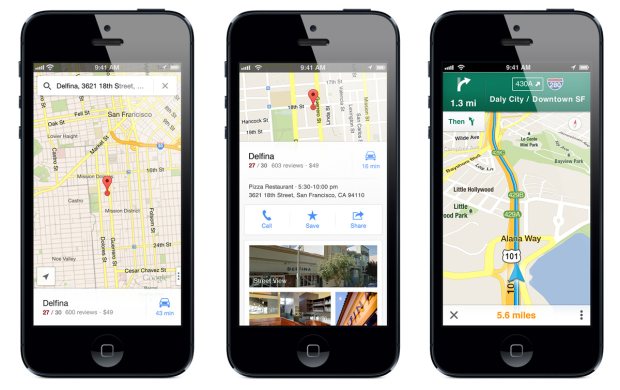
Google Maps for the iPhone is here, and it’s glorious. In only a few hours after launching, it’s become the top free iPhone app on the App Store.
It’s not hard to see why: The Google Maps iPhone app is gorgeously designed (just like the Gmail iPhone app, which launched last week), and it finally gives iOS 6 users a full-featured alternative to Apple’s troubled Map app.
To learn more about how Google approached building the long-awaited app, we chatted with Daniel Graf, director of Google Maps for mobile. Graf joined Google last year as director of its Mobile Apps Lab after founding the cloud-based video publishing platform Kyte in 2005. In April (shortly before Apple announced iOS 6 and its own map app), he took charge of the mobile maps team.
VentureBeat: How long have you been working on this?
Daniel Graf: We haven’t announced that. Usually Google doesn’t comment on how long it works on a product … what I can say is that it’s probably longer than what you would expect.
Creating a mapping application from the ground up is actually quite challenging from a technical point. It’s not just rendering some pictures and text. Rendering a map is similar to creating a 3D game, where you have a 3D rendering engine, which we created. To have the performance you see now, where you can zoom and pan at this speed is quite a challenge. And of course, hooking it up to all of the data sources we have on Google came on top of it.

VentureBeat: The design really falls in line with the new Gmail App on iOS and Google Now on iOS and Android. Is this a new, consistent style for Google on mobile?
Graf: I think what you’ve experienced on Google properties on the desktop over the last couple years, we have now kind of a streamlined design — a very delightful design which puts the product on the foreground. If you look at our app, the map is really the U.I. There aren’t many menus, but if you actually play around with it, you’ll see all of the features are actually here. You’re not actually missing anything.
You’re right — on the mobile side, of course, all of the mobile development teams collaborate closely to get this one Google experience onto mobile devices.
VentureBeat: It seems vastly improved over what we’ve been seeing in Google’s apps before. Is this something you’ve pushing since you joined the company last year?
Graf: This is always a team effort — there’s no individual part of this. I’m very happy to be a part of the team.
VentureBeat: Do you have any sense how Google approached mobile app design before you joined the team?
Graf: Mobile apps really only took off a few years ago with the smartphones. In the beginning, before you run, you have to walk, and before you walk, you have to crawl. So there were the crawling efforts, and I think now we’re on the walking side — and hopefully soon we’ll be running. I don’t think this is attached to me, this is just what’s happening in the industry overall. We’re seeing better and better designed products.
As you pointed out, it’s quite nice that Gmail launched last week; you can see a common design theme there. If you actually look at the app store rating, we’re at four-and-a-half stars now. We don’t get that quite often, and we’re pleased about that.
 VentureBeat: Are you surprised by the quick uptake on the app?
VentureBeat: Are you surprised by the quick uptake on the app?
Graf: [Laughs] You can never expect anything like that. We knew that there was the demand — people loved Google Maps in general. Our statement has always been that we want to be on all major platforms. Looking at the numbers, we are impressed.
VentureBeat: Was the Apple approval process difficult?
Graf: We work with Apple on a daily basis, and on many levels, Google and Apple have a very deep relationship. On the map side, all I can say is that we have a friendly relationship. You see the app out there now, and everything is working smooth. I think everyone around the table is happy about this today.
VentureBeat: Is it the same team building the iOS and Android versions of the app?
Graf: I’m responsible for all mobile platforms.
 VentureBeat: Why are you pushing new designs on iOS first? It seems that, historically, Android has received updates like this first.
VentureBeat: Why are you pushing new designs on iOS first? It seems that, historically, Android has received updates like this first.
Graf: If you look at the Android Play store, users are very happy with what we have there — we have a working solution there. On iOS, we didn’t have one. Obviously, our priority was focused on iOS and iPhone in recent months. Moving forward, our goal is always to have the best experience on every platform.
We’re not saying, “We’re going to have feature parity everywhere,” but we definitely want a seamless experience on all platforms.
VentureBeat: Should we expect an updated version of Google Maps on Android to look like this eventually?
Graf: If you look back, we update on Android very frequently. We’re not planning to push that moving forward.
VentureBeat: What exactly are you trying to accomplish with the Google Maps SDK and the new URL scheme for developers?
Graf: With Google in general, it’s not just about our applications, the way we design it. We want to enable an ecosystem. And that’s what we did here as well. Maps has a long history with APIs on the web, and on iOS our goal was the moment we launched the app, we wanted to launch the ecosystem.
VentureBeat: Do you think Apple would ever let third-party apps like Google Maps replace its built-in apps?
Graf: You’d have to ask Apple about that.We made this app, it’s on the app store, it’s out there now, and that’s all we care about.
VentureBeat: How important was it for you to keep public transportation within the app? That’s one big difference from Apple’s Maps app.
Graf: It’s absolutely essential. I think there’s a few things we really wanted to hit on with this new experience. We had the opportunity here to design something from the ground up, so design was our main focus, to have the best experience out there that nails all your use cases.
In most metropolitan areas a lot of people don’t need a car. Google has been known to have quite a comprehensive solution around the globe. We actually cover over a million transit spots — that’s not 100 percent coverage around the world. But in major metropolitan areas, we think we have very good coverage.
VentureBeat: When will we see an iPad version of the Google Maps app?
Graf: We usually don’t comment on future product releases. It is functional on the iPad — it’s not an optimized iPad experience at this point. But you can imagine that smartphones are the top priority for mapping, and mobile mapping is primarily used on smartphones. I would say stay tuned.
Top photo: Daniel Graf/Google+
VentureBeat's mission is to be a digital town square for technical decision-makers to gain knowledge about transformative enterprise technology and transact. Learn More
